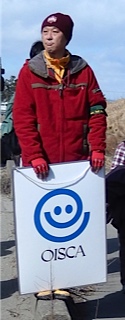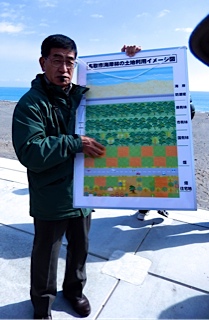Planting Hope #2 — OISCA
- At July 27, 2016
- By anneblog
- In Annes Letters
 0
0
A few months ago I wrote about a tree-planting project going on just outside of Sendai, in a town called Natori. An NGO called OISCA is deeply involved in that life-enhancing work.

Part of their job entails gaining support of locals, so they do all they can to include them in planning and activities. For example, they subcontract local tsunami survivors, many of whom are farmers. Those folks have helped start the seedlings, are nursing them carefully, and will be part of the team to plant the baby trees in the spring.
Recently, too, OISCA has held town meetings to explain their project to the people in the area. Also the other day they ran a morning tour of places where they had been working. Since I am keenly interested in what is happening in this region, I signed up to join them.
This tour was for educational purposes, so there was Professor Ota Takehiko, Professor Emeritus of Tokyo University, plus several other experts on pine trees and forests. The Mayor of Natori City also joined us. These gentlemen shared many interesting points about black pine trees and why there were the best choice for this area.

As the bus rolled out to the coastal areas, we looked at charts and listened to explanations about the intricacy of this vast, far-reaching endeavor. We learned that black pine trees have an extremely sturdy root system. They are very hardy trees, but also sensitive to the earth they are in. So if the land is low, the roots tend to spread horizontally. But even with a slight rise, they will grow vertically and deeply, which makes for a more stable outcome.

And sure enough, as we went through the low, almost treeless, tsunami-hit areas, we passed a teeny pimple of risen land. A small shrine had been built there, and lo and behold, pine trees were tenaciously clinging to the soil around it. They had survived the tremendous force of the tsunami, although all the trees just next to them on lower ground had perished.

I have wandered many times in the area where OISCA is working. However, I had never realized that wonderful organization was part of the rebuilding going on in that specific place. I had mostly seen trucks plying back and forth, moving salt-filled earth and replacing it with fresh soil. I know about the park to be built behind the sea wall. And I had listened to the tales of farmers losing their land because of all these changes. But this time I was able to learn about the master plan for this devastated area.
The sea wall is there, in concrete. But behind that there is a man-made rise of land with triangular wooden frames. I had photographed those structures on previous occasions, but this time I learned their specific purpose. They are there to protect the young black pine forest that OISCA is helping to birth.

Wind is a huge factor in this stretch of land between the mountains and the sea. Yet, strangely, the protective wooden frames are not solid. Rather, they have many slats. Those breaks in the sides of the frames are for the wind to go through, while still protecting the precious new life of the saplings. If the frames were solid, the wind would swoop up violently and then pound down hard on the earth, causing great damage to both the soil and the plants. But with the space, the air goes through evenly, and skims across the land relatively smoothly. In that way, the trees are better able to withstand the fierce gales that are notorious in this region.

There are three rows of financial responsibility for this immense project. The strip of land closest to the ocean is Miyagi Prefecture’s domain. The next is Natori City’s concern. The final one is the Japanese government’s area. OISCA is involved in all three of them, providing the expertise, management, and direction needed for this ten-year project to materialize. Beyond the forest park will be a buffer zone then farms and a road. Three kilometers and further inshore will be the homes of locals.

At the end of the tour we went to see the seedlings and baby pine trees that have been stretching and growing over the winter. The planning of this project is very precise. At first ten grams of seeds are planted in one-meter square areas. As they grow, they are thinned out. When the actual planting of the forest takes place, the trees will be placed 1.4 meters apart. OISCA is talking about 50,000 trees, so you can imagine the work involved and the enormous area to be covered.

The best time to transplant is when the infant trees are from 25–35 centimeters high. In order to prevent them from growing beyond that height, these babies are deliberately not fertilized. If they were given extra nutrients, they would grow too quickly and too large. That would cause problems later when it came time to shift them to their permanent locations.
When OISCA first began working here, they planted seedlings directly into the soil. There were nets to protect the baby shoots from the wind. However, later the government passed a law that seedlings had to be planted in small plastic containers in greenhouses. The work is easier that way, but unfortunately it is also more expensive. That frustrates the situation, but rules are rules, so OISCA complies.

Before arriving at OISCA’s “seeding farm”, we went quite far down the beach, further than I had ever walked. There amid the high grasses was a stone monument. It had been placed there many years before. Miraculously, it had withstood the tsunami with only a broken top.

Ironically, it was there to commemorate a tree-planting project that had been executed long, long ago by locals. They were not professionals – maybe students, office workers, housewives, and farmers. But the trees had lasted for years, even though they were all gone now.
OISCA’s project is similar, but more professional, with technological expertise and precision. But the heart is the same: the desire to make Miyagi a viable area for farming, fishing, and living – with trees as the backbone and nurturing mother for centuries to come.

Love,



